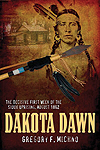
Dakota Dawn: The Decisive First Week of the Sioux Uprising, August 17–24, 1862, by Gregory F. Michno, Savas Beatie, New York and El Dorado, Calif., 2011, $32.95
Indian wars historian Gregory Michno made a big splash in his chosen field with his June 1996 Wild West article “Lakota Noon at the Greasy Grass” and his 1997 book Lakota Noon: The Indian Narrative of Custer’s Defeat. Since then he has turned out such fine books as The Encyclopedia of Indian Wars and Deadliest Indian War in the West: The Snake Conflict, 1864–1868. In the unsung five-year Snake War, Michno points out, 1,762 soldiers, civilians, scouts and Indians died. In comparison, the Great Sioux War of 1876–77 (which included the Battle of the Little Bighorn, the subject of Lakota Noon) recorded an estimated 847 casualties on both sides. Third on the deadliest Indian wars of the West list (though most of the fighting didn’t involve actual U.S. soldiers) would be the often-forgotten Minnesota Sioux Uprising, in which about 800 people died (644 of them white settlers).
Even many frontier history aficionados would not have guessed that the Minnesota Sioux Uprising was No. 3. What’s more, all those deaths of settlers and Dakota Indians in Minnesota came in just five weeks (August 17–September 23, 1862), and the fighting there triggered Army vs. Indian fighting in Dakota Territory for another three years. The Dakota Uprising (the collective 1862–65 fighting in Minnesota and Dakota Territory), writes Michno, “grew into the greatest of the Sioux wars, eclipsing the misnamed ‘Great Sioux War’ of 1876–77.” But that’s actually jumping ahead of Michno’s latest offering. As the subtitle of Dakota Dawn indicates, the 442-page book covers only the first week of the Minnesota Sioux Uprising.
But what a week it was. The Dakotas, by twice attacking a town (New Ulm) and even a fort (Ridgely) and by killing at least 400 settlers, realized their objective of driving off the newcomers and regaining their land along the Minnesota River. After those first seven days the fighting and killing continued, but, as Michno notes, “the Dakotas’ bubble burst even before the white soldiers arrived.” The author uses diaries, newspapers and original records (particularly the Indian Depredation Claim files) to provide never-before-published details of the conflict.
—Editor




